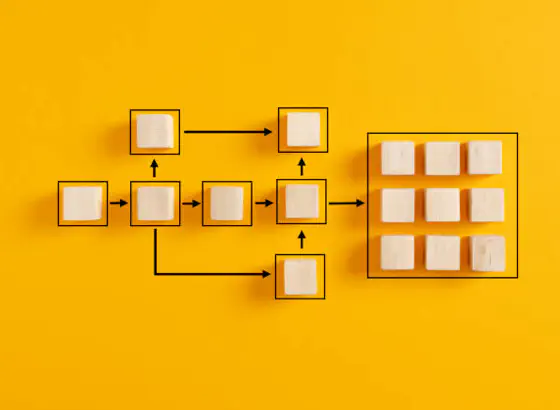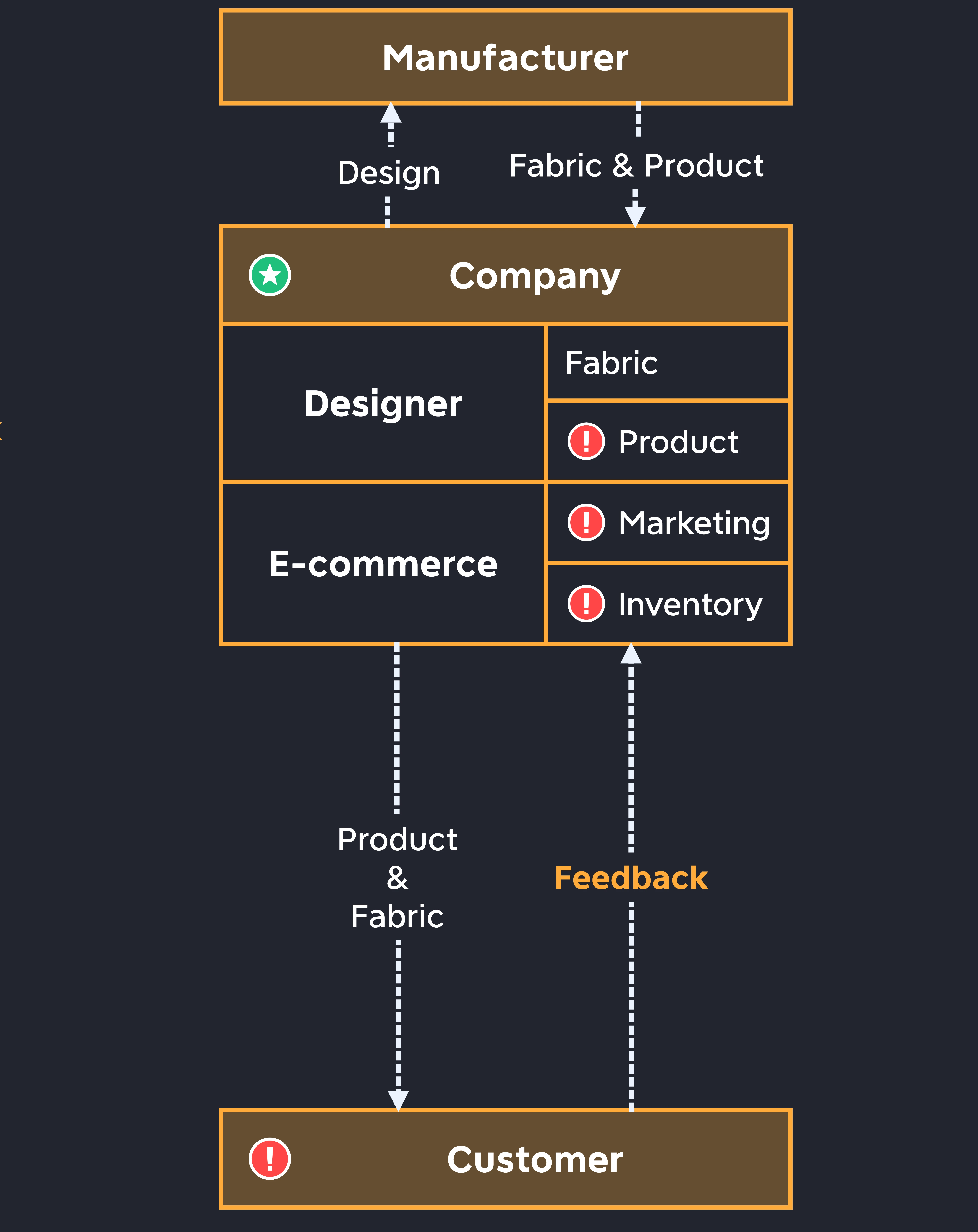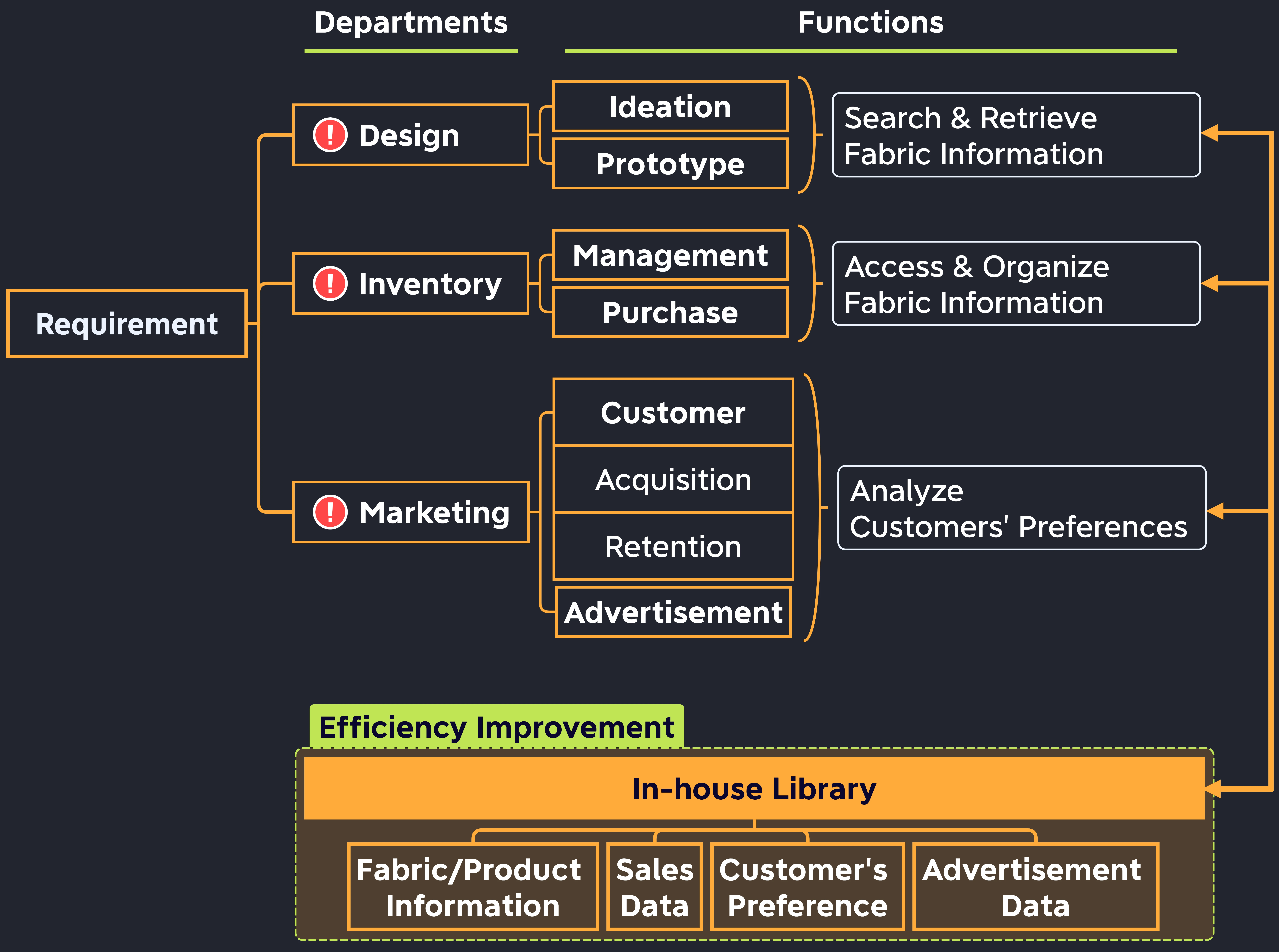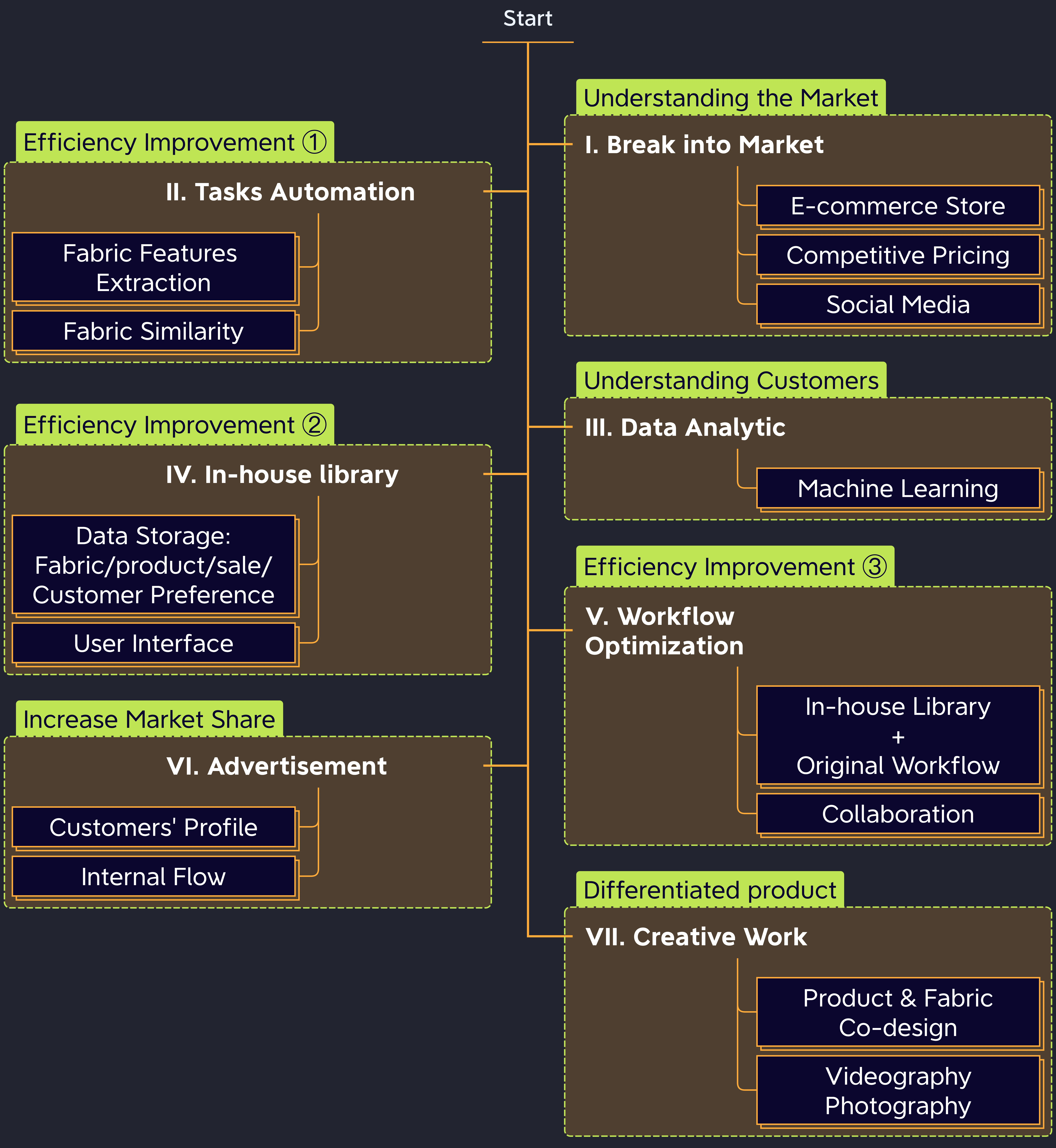Transitions toward B2C E-commerce: Part I

Table of Contents
Abstract
The document discusses a proposed transition from a B2B fabric design business model to a B2C e-commerce model for a Taiwan-based company named “Haori Taiwan”. The advantages and disadvantages of the original model are listed, and a proposed solution is presented. The document then analyzes the requirements of the transition in both system and business aspects, and presents the achievements of each milestone. The impact of the transition is quantified using measures of productivity, popularity, and sales, and the conclusion notes that the transition has improved total sales in Taiwan by 378% compared to March 2017.
1. Introduction
Our company, “Haori Taiwan”, is based in Taiwan and specializes in fabric design. The company’s business model is illustrated in Fig. 1(a). Designers send their designs to manufacturers, who produce the fabric that we then sell to product design houses and distributors. The advantages and disadvantages of this model are listed below:
- Pros:
- The business is straightforward
Our main tasks are designing fabric and communicating with manufacturers, distributors, and product design houses. - Low operational costs
Since the company primarily consists of designers, there is no need to have a large working area such as a factory or multiple stores. As a result, the operational costs are much lower than those of manufacturers and retailers.
- The business is straightforward
- Cons:
- Long sales cycle
Starting from the delivery design, it takes months to manufacture, ship abroad, and receive payment from clients. This process is risky and presents a challenge for cash flow management. - Lack of direct awareness of market trends
Without direct feedback from customers, it’s possible that the design may fall out of fashion. We can only react once our client reports a decline in sales.
- Long sales cycle
The (a) original and (b) proposed business models of the company.
(a) Original modelshow hide

(b) Proposed modelshow hide

To address these disadvantages, we propose transitioning to a B2C business model, depicted in Fig. 1(b). This approach is similar to that taken by the Finnish fabric design house, Marimekko. It involves adding product design capabilities and establishing an e-commerce store to directly sell fabric and products to customers. The objective of this transition is to overcome the drawbacks while maintaining the benefits of the original business model.
2. Analysis of the Transition
To achieve our goals for this business transition, we need to solve two main problems:
- System-wise:
- We need to add three departments to our company: product design, marketing, and inventory. However, simply hiring more employees to implement this transition could turn the previously mentioned benefits into drawbacks.
- Business-wise:
- What is the most effective way to reach potential customers? In other words, what is our plan to enter the market?
2.1. System-wise
Our goal is to maintain the advantages of the original model while simplifying the workflow and minimizing operational costs. To achieve this, we will take the following approach:
- Break down the requirements of the business transition.
- Analyze the tasks involved in each part.
- Reduce repetitive and tedious work.
In essence, our objective is to improve work efficiency and accomplish more tasks without the need to hire additional employees. This approach is also beneficial in the long-term since it reduces the time spent on human resource management, lowers operational costs, and makes the company more resilient and flexible during times of transition.
We start by considering the requirements, as shown in Fig. 2. Compared to the original business model, there are three additional parts: design, inventory, and marketing. Although their functionalities appear to be completely different, their workflows intersect with each other. For example, the designer may need information about customer preferences while searching for fabric, and the inventory planner may need to organize fabric based on sales or customer preference so that the designer can easily find the required fabric. Therefore, building an in-house library containing information required by different departments can significantly improve efficiency.
Analysis of requirements for business model transition.

2.2. Business-wise
We conduct competitor analysis and SWOT analysis. The strategy and milestones are established as depicted in the Fig. 3, which are elaborated in detail in “Transitions towards B2C E-commerce: Part II - Competitor Analysis and Strategy Formation”.
Milestones of the transition plan.

3. Result
3.1. Data
To measure the impact of the business model transition, we selected four metrics as shown in Fig. 4:
- Number of Facebook posts per month
- Average reactions per post on Facebook per month
- Printed fabric sales in Taiwan
- Total sales in Taiwan
The number of posts and average reactions reflect productivity and popularity, respectively. Sales data is normalized to the sales in February 2017, and a four-quarter moving average is applied. The data for “Benchmark” is from Competitor D in the previous competitor analysis.
(a) Comparison of our performance with that of our competitor in two metrics: the number of posts and the average number of reactions per post. (b) Four-quarter moving average of fabric and total sales in Taiwan.
(a) Posts on Facebookshow hide
━━ Benchmark
(b) Four-Quarter Moving Average of Sales in Taiwanshow hide
━━ Total Sales
3.2. Milestones
To provide more context about our development process, we have divided the timeline from February 2017 to August 2021 into three phases, which are described separately.
- Phase I:
- We entered the market by using competitive pricing and selling a similar product (printed fabric), and promoting it on social media. This was the strategy identified in our competitor analysis. Despite achieving significant sales improvements, we were still lagging behind our competitors on social media.
- Result on Sales:
Sales growth of 289% for fabric and 73% in total (from 2017/3 to 2018/3).
- Phase II:
- We improved work efficiency by building an in-house library, automating workflows, and optimizing processes. This has had a positive impact on our social media presence, with the number of posts increasing by 5.35 times compared to January 2018, and post reactions increasing by 6.88 times compared to January 2018. Additionally, we have surpassed our competitor in terms of the number of posts.
- Cluster analysis was also performed to identify customers’ preferences, which helps reduce purchase processing time and relocate budgets more effectively.
- The COVID-19 pandemic has impacted the logistics and import procedures of fabric, limiting the growth of fabric sales. However, due to our increasing popularity on social media, sales of other products have also increased.
- Result on Sales:
Sales growth of 289% for fabric and 67% in total (from 2018/3 to 2019/3).
Sales growth of -7% for fabric and 28% in total (from 2019/3 to 2020/3).
- Phase III:
- As mentioned in the SWOT analysis, short-term opportunities on social media are decreasing, which is impacting sales. As a result, we have focused on increasing our market share through advertising and creating unique products.
- At the end of Phase II, we observed a diminishing marginal effect on Facebook posts. This means that the number of posts is no longer proportional to popularity. As a result, we decided to shift our focus from productivity to creativity. This change helped us surpass our competitors in popularity for the first time.
- Result on Sales:
Sales growth of +13% for fabric and +3% in total (from 2020/3 to 2021/3).
To sum up, this business transition has improved total sales by 378% compared to March 2017.
The actions and results of each milestone are summarized in the following table
| Phase | Milestones | Actions / Results |
|---|---|---|
| I | Break into Market | Creating daily video tutorials is the most effective way to reach customers. We use competitive pricing and sell similar products as a means to enter the market. More details: *Transitions towards B2C E-commerce: Part II - Competitor Analysis and Strategy Formation |
| II | Tasks Automation | We have implemented algorithms to automatically extract fabric features and find similar fabrics. This achieved processing speeds 12 to 63 times faster than human processing, with 98% accuracy. More details: *Color Theme Extraction Based on the Bucket Sort Algorithm *Repeated Pattern Detection of Printed Fabric *Investigation of Algorithms for Retrieving Similar Images |
| II | Data Analytic | We performed cluster analysis on our fabric sales data, resulting in two improvements: First, we reduced processing time for each purchase by 50%. Second, we allocated our budget more effectively, resulting in up to a 4x improvement in sales. More details: *Improving fabric sales through cluster analysis |
| II | In-house library | The library is implemented using the Django framework and deployed on the Google Cloud Platform. More details: *Design and Implementation of an in-House Fabric Library |
| II | Workflow Optimization | The revised workflow led to a 4.4x increase in the number of posts and a 3.2x increase in the number of reactions per post, all while maintaining the same operational budget as the original workflow. More details: *Workflow Optimization for Social Media Promotion |
| III | Advertisement | We use the RFM model and customers’ reactions on messenger apps to create profiles. These profiles are then used as the target audience for advertising. However, this workflow is still under development. |
| III | Creative Work | We reached 748k people with a single post and had a monthly reach of 1.2M on our Facebook page. More details: *Design Portfolio *Product Videography *Product Photography |
4. Conclusion
We first point out the disadvantages in the original B2B business model, and propose a transition to a B2C e-commerce model. Next, we analyze the requirements of this transition in both system and business aspects. In terms of the system, we break down the problem by examining the functionalities of each department and their intersections. We point out that building an in-house library can not only improve efficiency but also retain our advantages in the original business model. As for the business aspect, we perform competitor and SWOT analysis to establish a strategy and milestones.
To quantify the impact, we select the number of posts and reactions on each post as measures of productivity and popularity. Additionally, total sales and fabric sales are also selected.
We present the achievements of each milestone and briefly describe the context in three different phases. Although we have observed that the short-term opportunity on social media is fading in 2021, this business transition has improved total sales in Taiwan by 278% compared to March 2017.